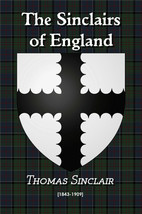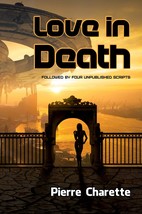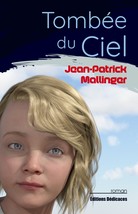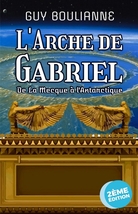The Sinclairs of England, by Thomas Sinclair and 50 similar items
The Sinclairs of England, by Thomas Sinclair
£16.73 GBP
View full item details »
Shipping options
Return policy
None: All purchases final
Purchase protection
Payment options
PayPal accepted
PayPal Credit accepted
Venmo accepted
PayPal, MasterCard, Visa, Discover, and American Express accepted
Maestro accepted
Amazon Pay accepted
Nuvei accepted
View full item details »
Shipping options
Return policy
None: All purchases final
Purchase protection
Payment options
PayPal accepted
PayPal Credit accepted
Venmo accepted
PayPal, MasterCard, Visa, Discover, and American Express accepted
Maestro accepted
Amazon Pay accepted
Nuvei accepted
Item traits
| Category: | |
|---|---|
| Quantity Available: |
1000 in stock |
| Condition: |
Unspecified by seller, may be new. |
| ISBN: |
9781770765603 |
| Format: |
Livre broché |
| Pays/région de fabrication: |
Canada |
| Langue: |
Anglais |
| Objet modifié: |
Non |
| Auteur: |
Thomas Sinclair |
| Caractéristiques spéciales: |
1re édition |
| Année de publication: |
2015 |
| Pays / région de fabrication: |
Canada |
| Sujet: |
Histoire |
Listing details
| Seller policies: | |
|---|---|
| Shipping discount: |
Items after first shipped at flat $5.00 |
| Posted for sale: |
More than a week ago |
| Item number: |
989631729 |
Item description
The Sinclairs of England
by Thomas Sinclair
ISBN : 978-1-77076-560-3
Format : 416 pages, 6 x 9 inches
Interior Ink : Black white
Binding : Perfect-bound Paperback
The Sinclairs descend from Tognvald "the Mighty", Earl of Moere in Norway and of the Orkneys. In 876 his son Hrolf "the Ganger" entered the River Seine and pillaged the countryside. King Charles "the Simple" of France made peace by granting him the Province of Normandy, and the overloardship of Brittany. The treaty was signed at Castle Saint-Clair-Sur-Epte... William The Conqueror was a first cousin of the St Clairs. Nine Sinclair knights fought with him at the Battle of Hastings. The St Clairs were granted vast estates in England.
The St Clair presence in Scotland pre-dates the Norman Conquest. William St Clair accompanied Edgar "the Atheling" to Hungary and later escorted Edgar's sister Margaret to Scotland with the Holy Rood, part of the true cross. William was granted Rosslyn "in life-rent" by the King in 1057. Rosslyn has been in the family's hands ever since. William was succeeded by Henri de St Clair, who took part in the First Crusade and the Fall of Jerusalem in 1096. This was the beginning of the Sinclair involvement with the Crusades and the Knights Templar.
The Knights Templar were welcomed to Scotland by Robert The Bruce after the Order had been suppressed by the Pope. The Sinclairs allowed them to set up a headquarters at Ballintradoch, on the Rosslyn Estate. At the Battle of Bannockburn in 1314, Sir William Sinclair and two sons led out the Knights Templar to rout the English army. This victory is still remembered by the Knights Templar at a ceremony at Bannockburn on St John's Day.
In 1398 Henry Sinclair, Earl of Orkney and Prince of Norway, set sail for the New World with 200 men-at-arms in 12 ships fitted with cannon. They reached Newfoundland and later sailed on to Nova Scotia, Henry built a settlement. Further proof of Henry's voyage is visible in Rosslyn Chapel there are carvings of Indian Maize and North American Aloe cacti, all carved before Columbus was born.
The Sinclairs produced many notable persons. Among them was Sir John Sinclair of Ulbster, who was first President of the Board of Agriculture at the time of Pitt, and the compiler and editor of the First Statistical Account of Scotland, 1791-99. Another famous descendant was Major General Arthur St Clair who served with Amherst at Louisberg and with Wolfe at Quebec. However, during the American War of Independence he was a trusted adviser of General Washington and served at many battles. He was President of Congress and Governor of the North-western Territory of the USA.
ABOUT THE AUTHOR:
Thomas Sinclair was born in 1843 in Scotland, the second son of George Dunbar Sinclair and Helen Graham. He attended Edinburgh University, the New College, and the Sorbonne, earning an M.A. along the way. Sinclair worked as a tutor before turning to journalism in 1874—thereafter he became a prolific writer of poetry, reviews, articles, travel, and criticism. In addition, he wrote one novel, Goddess Fortune (1884), about children switched at birth. He travelled widely, living for a time on the continent and in Algeria. He never married and was still living in 1907 in Bournemouth.
|
Why are we showing these items?
Booth
Editions Dedicaces |

|

-
Refine your browsing experience
We can show you more items that are exactly like the original item, or we can show you items that are similar in spirit. By default we show you a mix.
This item has been added to your cart
 The Sinclairs of England, by Thomas Sinclair added to cart.
1000 available in stock
The Sinclairs of England, by Thomas Sinclair added to cart.
1000 available in stock
View Cart or continue shopping.
 Please wait while we finish adding this item to your cart.
Please wait while we finish adding this item to your cart.
Get an item reminder
We'll email you a link to your item now and follow up with a single reminder (if you'd like one). That's it! No spam, no hassle.
Already have an account?
Log in and add this item to your wish list.

























































